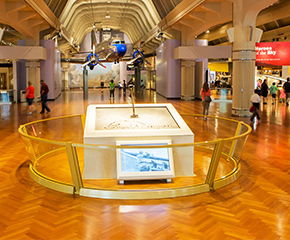
Model T
29 artifacts in this set
Brochure for the 1924 Ford Model T Car, "Make Pleasure Island a Treasure Island for the Whole Family"
Trade catalog
Car brochures have evolved from straightforward product catalogues into polished creative sales tools. Their quality paper, rich color, inventive formats, and sophisticated graphic design all contribute to a buyer's developing impression of a car in a showroom. Advertising might entice people to a dealership, but brochures extend and deepen the relationship between vehicle and potential buyer.
Magneto Assembly at the Ford Highland Park Plant, 1913
Photographic print
The first Ford assembly line at the Highland Park, Michigan, plant was relatively crude. Here, in 1913, workers put V-shaped magnets on Model T flywheels to make one-half of the flywheel magneto. Each worker installed a few parts and simply shoved the flywheel down the line to the next worker.
Publication, "Ford at the Panama-Pacific Exposition, San Francisco, 1915"
Publication (Document)
This Ford Motor Company leaflet discusses its exhibit at the Panama-Pacific Exposition, the Model T, and its U.S. factories. The image of the main plant at Highland Park, Michigan, illustrates the comprehensive manufacturing operations. The plant had facilities for casting, machining, stamping, assembly, and shipping. The massive power plant with five smokestacks generated the factory's electricity.
1923 Ford Model T Suspension Adjusting to Uneven Terrain, Staged in 2003
Photographic print
On August 5, 2003, modern Ford Model T enthusiasts demonstrated their cars' suspensions adjusting to uneven terrain on a road in Colorado's San Isabel National Forest. Ninety-five years earlier, the Model T's ability to easily traverse the nation's terrible roads helped make it more popular than other early 20th century automobiles.
1909 Ford Model T Touring Car
Automobile
Henry Ford crafted his ideal car in the Model T. It was rugged, reliable and suited to quantity production. The first 2,500 Model Ts carried gear-driven water pumps rather than the thermosiphon cooling system adopted later. Rarer still, the first 1,000 or so -- like this example -- used a lever rather than a floor pedal to engage reverse.
1914 Ford Model T Touring Car, Given to John Burroughs by Henry Ford
Automobile
This 1914 touring car is one of several Model T automobiles given to naturalist John Burroughs by his friend Henry Ford. Ford Motor Company experienced a milestone year in 1914. The automaker fully implemented the moving assembly line at its Highland Park plant, and it introduced the Five Dollar Day profit-sharing plan for its employees.
1919 Ford Model T Sedan
Automobile
The Model T's basic design received many updates over the car's 19-year life. Some incorporated mechanical improvements, some responded to growing consumer demands, and some simply reduced costs. The 1919 sedans were the first with electric starters and demountable tire rims. These features were standard on other makes but cost extra on a Ford, keeping the base price low.
Henry Ford and Edsel Ford in Fifteen-Millionth Ford Model T Car on the Last Day of Model T Production, May 26, 1927
Photographic print
On May 26, 1927, Edsel and Henry Ford drove the fifteen-millionth Model T out of Highland Park Plant. This marked the symbolic end of Model T production and Ford Motor Company prepared to start producing the Model A. This image shows Edsel and Henry in the fifteen-millionth Model T, outside the Engineering Laboratory in Dearborn, Michigan.
1927 Ford Model T Touring Car, The Fifteen-Millionth Ford
Automobile
After 19 years and some 15 million cars, Ford Motor Company ended production of its venerable Model T. Company officials designated this car as the Fifteen Millionth and ceremonial "last" Model T. They gathered at Ford's Highland Park plant to watch Henry Ford and Edsel Ford drive it off the assembly line on May 26, 1927.
Ford Model T in the Mud during the New York-Seattle Transcontinental Race, 1909
Photographic print
Ford Motor Company promoted the Model T's reliability by entering two cars in the 1909 Transcontinental Race from New York to Seattle. It was a demanding contest over rough country at a time when roads were nearly nonexistent. After 23 days, one of the Model Ts reached Seattle first. It was later disqualified due to repairs made en route.
Family in Ford Model T in Front of Farmhouse, circa 1910
Photographic print
The Model T was particularly beneficial to farm families. While those in the city had access to railroads and streetcars, or could bicycle on paved roads, the farmer was limited to the distance his horse -- or feet -- could travel. The affordable Model T ended that isolation for good.
Ford Model T Chassis Being Lined up outside the Highland Park Plant, circa 1913
Photographic print
Ford Motor Company's Highland Park plant hummed with activity during the 1910s. With the introduction of the moving assembly line, the plant went from building some 200,000 Model Ts in 1913 to more than 820,000 in 1919. Here workers are seen lining up chassis outside the plant for a publicity photo. The final shot showed 1,000 chassis -- one shift's production in 1913.
Sawing Wood Using the Ford Model T Sawmill Conversion, circa 1919
Photographic print
Innovative users adapted the Ford Model T to their needs. The Ford's rear axle powered many types of belt driven machinery. This photograph taken about 1919 shows men preparing to cut wood on a portable sawmill powered by a Model T.
Ford Model N Chassis in Assembly Room at the Piquette Avenue Plant, 1906
Photographic print
In 1906 Ford Model Ns were assembled on the third floor of Ford Motor Company's Piquette Avenue factory in Detroit. Cars were put together by crews moving from vehicle to vehicle. No one had yet conceived of the moving assembly line. Behind the rows of cars are engines, stored on their noses to conserve space.
1906 Ford Model N Runabout
Automobile
Two-seater runabouts like this 1906 Ford Model N were favored by middle-class Americans who could afford one. They were fast and rugged. Most runabouts featured one- or two-cylinder engines and bicycle-style chain drives. But this Ford Model N offered four cylinders and a shaft drive, plus it cost less. At $500, it became the bestselling car in America.
1896 Ford Quadricycle Runabout, First Car Built by Henry Ford
Automobile
The Quadricycle was Henry Ford's first attempt to build a gasoline-powered automobile. It utilized commonly available materials: angle iron for the frame, a leather belt and chain drive for the transmission, and a buggy seat. Ford had to devise his own ignition system. He sold his Quadricycle for $200, then used the money to build his second car.
1903 Ford Model A Runabout
Automobile
After his first two attempts at commercial automobile manufacturing failed, Henry Ford found success with Ford Motor Company, established in 1903. The new company's first product, the Model A, was conventional by the standards of the day. It featured a two-cylinder engine mounted under the seat and rear wheels driven by a chain.
Henry Ford Riding in 1906 Ford Model N Car Outside the Piquette Avenue Plant, circa 1906
Photographic print
For Henry Ford, this Model N represented his ideal of "raising the automobile out of the list of luxuries, and bringing it to the point where the average American citizen may own and enjoy his automobile." A forerunner to the Model T, it proved to be a strong seller from 1906 to 1908.
Ford Model N Chassis in Assembly Room, Piquette Avenue Plant, Detroit, Michigan, 1906
Photographic print
In 1906 Ford Model Ns were assembled on the third floor of Ford Motor Company's Piquette Avenue factory in Detroit. Cars were put together by crews moving from vehicle to vehicle. No one had yet conceived of the moving assembly line. The chassis were stored in tight lines to conserve space.
Ford Model T Cutaway Chassis, circa 1926
Chassis (Vehicle component)
This cutaway was constructed in the workshops of Agencia Ford Stabile, a Ford distributor in Rosario, Argentina. It was assembled using miscellaneous Model T components from several different years (the engine block is 1922) -- amply demonstrating the interchangeability of Model T parts. It was exhibited in the distributor's showroom and at automobile shows in order to better familiarize Argentineans with the Model T.
Diagram of Ford Model T Engine Published in Ford Times, May 1914
Photographic print
First printed in 1908, Ford Times was published by Ford Motor Company and distributed to readers free of charge. Early issues targeted Ford dealers, but editors later broadened the magazine's content to appeal to Ford owners and potential buyers. This illustration, from the May 1914 issue, shows the inner workings of the four-cylinder engine that powered the Model T.
"Henry Ford's Model N" Clip from Interview with Bob Casey, 2011
Film clip
Bob Casey was the John and Horace Dodge Curator of Transportation at The Henry Ford.
Women in a Ford Model N Roadster, circa 1907
Photographic print
American women welcomed the automobile's mobility and implied freedom. Cars arrived at a time when women were increasingly breaking away from the traditional domestic sphere and making new inroads in the workplace and in civic engagement. The automobile accelerated that social change.
1906 Ford Model N and 1925 Ford Model T
Photographic print
Ford Motor Company introduced the Model N in 1906. Priced at $500, it marked an important step toward Henry Ford's goal of a quality low-priced automobile. The Model N was succeeded by the Model T in 1908, which fulfilled Mr. Ford's vision and remained in production until 1927. By the early 1920s, a two-seat Model T cost as little as $260.
Ford Model T Chassis Drawing from a 1912 Catalog
Photographic print
Throughout the Model T's 19-year production run, Ford Motor Company sold running chassis in addition to complete, bodied cars. Buyers could fit a chassis with a special body suited to their needs. That body might be sourced from a professional builder or, if the buyer had the necessary skills, scratch-built at home.
Ford Model T Race Cars during the New York to Seattle Transcontinental Race, June 1909
Photographic print
These Ford Model Ts are headed from New York to Seattle in America's first transcontinental race. Six cars battled over 4,106 miles of bad roads, trails, and wilderness. The Model Ts took first and third (though one was later disqualified for an illegal mid-race axle change), illustrating their hardy ability to surmount deep ruts, big rocks, and muddy terrain.
Henry Ford and Others with Ford Model T Cars Awaiting Start of New York-to-Seattle Race, 1909
Photographic print
Ford Motor Company promoted the Model T's reliability by entering two cars in the 1909 Transcontinental Race from New York to Seattle. It was a demanding contest over rough country at a time when roads were nearly nonexistent. After 23 days, one of the Model Ts reached Seattle first. It was later disqualified due to repairs made en route.
This is user-generated content and does not reflect the views of The Henry Ford.


